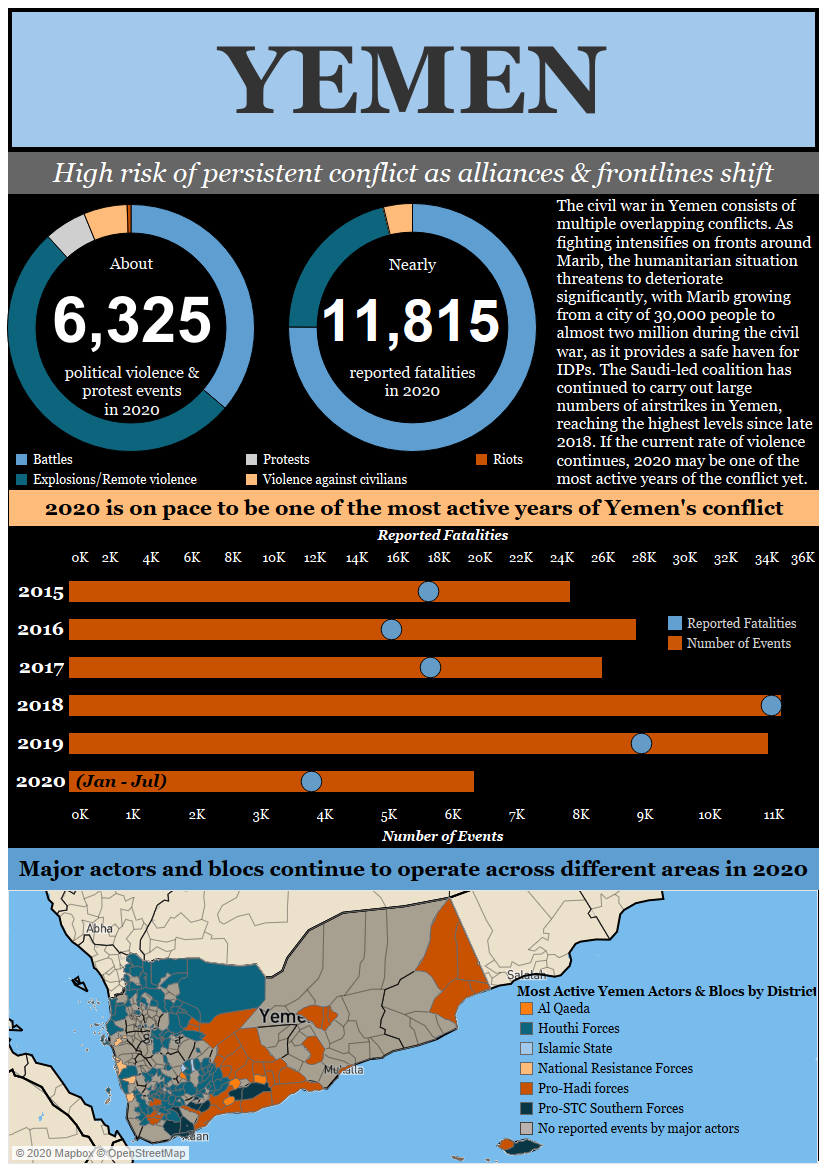YEMEN
Yemen’s civil war continues unabated. Backchannel negotiations between the Houthi movement and Saudi Arabia (Middle East Institute, 15 April 2020) significantly reduced cross-border attacks and airstrikes in the first quarter of 2020.
Without a successful conclusion to these talks, however, Houthi forces have intensified offensives to advance on Marib city, the anchor and stronghold of the internationally-recognized government.
Gaining control of Marib city would open up the possibility for Houthi forces to access the nearby oil and gas resources (Twitter, 2 July 2020). However, sanctions and the Saudi blockade will make it difficult for them to sell these resources on the international market.

Houthi forces managed to capture Al Hazm on 1 March, the provincial capital of Al Jawf governorate, and have advanced on Nihm and Sirwah fronts further towards Marib. By mid-2020, however, frontlines stagnated around Marib without any significant advancements by either side.
In the same vein, a small tribal uprising in Radman al Awad in April, led by Yaseer al-Awadhi, was crushed by Houthi forces (Middle East Institute, 22 June 2020), subsequently enabling Houthi forces to capture Qaniyah and surrounding territories, opening up another possibility to move towards Marib from the south.
Simultaneously, to alleviate pressure on forces fighting for the internationally-recognized government, Saudi-led coalition airstrikes have upticked significantly, reaching their highest levels since late 2018 — before the conclusion of the Stockholm Agreement and later the initiation of Houthi-Saudi backchannel talks in September 2019. Houthi attacks on Saudi Arabia, however, have remained at their lowest levels since June 2016, with very few intrusions into Saudi territory reported.
The main modes of operation include drone strikes and ballistic missile attacks, which the Saudi military claims to intercept in most cases. Still, compared to the first half of 2019, half as many of these attacks have been reported.
In the southern provinces, there has been an increasing number of contentious hotspots. In the first half of 2020, confrontations between pro-Southern Transitional Council (STC) forces and forces belonging to the internationally-recognized government continued to take place, despite the conclusion of the Riyadh Agreement in October 2019. The Riyadh Agreement has not yet been successfully implemented, despite several amendments in recent months.
The latest of these amendments at the end of July has been lauded by the STC and the internationally-recognized government. As a result, the STC retracted its declaration of self-administration over Yemen’s south from April 2020. The plan has seen the appointment of a new security director and a new governor for Aden, though both are STC-affiliated (Twitter, 29 July 2020). The STC, however, retains de facto control of Aden, Lahij, parts of Abyan, and Ad Dali, and took control of the strategic Socotra island in June 2020 (Reuters, 21 June 2020).
How the renegotiated deal from July 2020 will be implemented in the second half of 2020 remains yet to be seen. In all southern governorates, the success of implementation will be crucial in determining future patterns of violence.
The ultimate outcome of the Houthi advance on Marib on one hand, and the de facto success of the Riyadh Agreement on the other, will be critical for the future of the war in Yemen in 2020.
The civil war consists of multiple overlapping conflicts, with multiple domestic and foreign actors with competing interests and divergent capabilities. As fighting intensifies on fronts around Marib, the humanitarian situation threatens to deteriorate significantly, with Marib growing from a city of 30,000 people to almost two million during the civil war, as it provides a safe haven for IDPs (International Crisis Group, 17 April 2020).
On the other hand, Saudi efforts to push for the implementation of the Riyadh Agreement raise some hope that conflict in the southern governorates will decrease in the second half of 2020.
Finally, if Saudi-Houthi backchannel talks are reactivated and result in a partial Saudi disengagement, it will have a major effect on the trajectory of the war. Nevertheless, as long as the different Yemeni sides do not come to an agreement between themselves, violence will continue — as evidenced by the Houthis starting an offensive on Marib in the first half of 2020, precisely when Saudi Arabia has shown willingness to disengage.
The coronavirus pandemic — despite infections in Yemen being widespread since April, reportedly leading to severe medical shortages (Sky News, 18 May 2020; AP, 9 June 2020) — has not significantly impacted the trajectory of the war in Yemen.
If you want to read the articles in order, click on PREVIOUS or NEXT PAGE
Or, Please click through the drop-down menu below to jump to specific cases.
MEXICO
YEMEN
INDIA
SOMALIA
IRAN
AFGHANISTAN
ETHIOPIA
LEBANON
UNITED STATES
ACLED / Balkantimes.press


